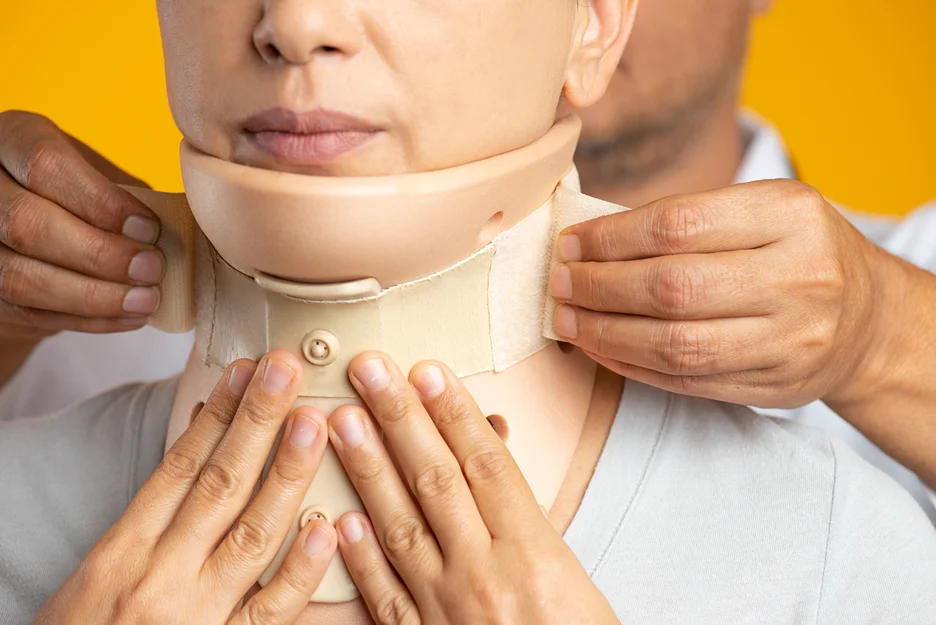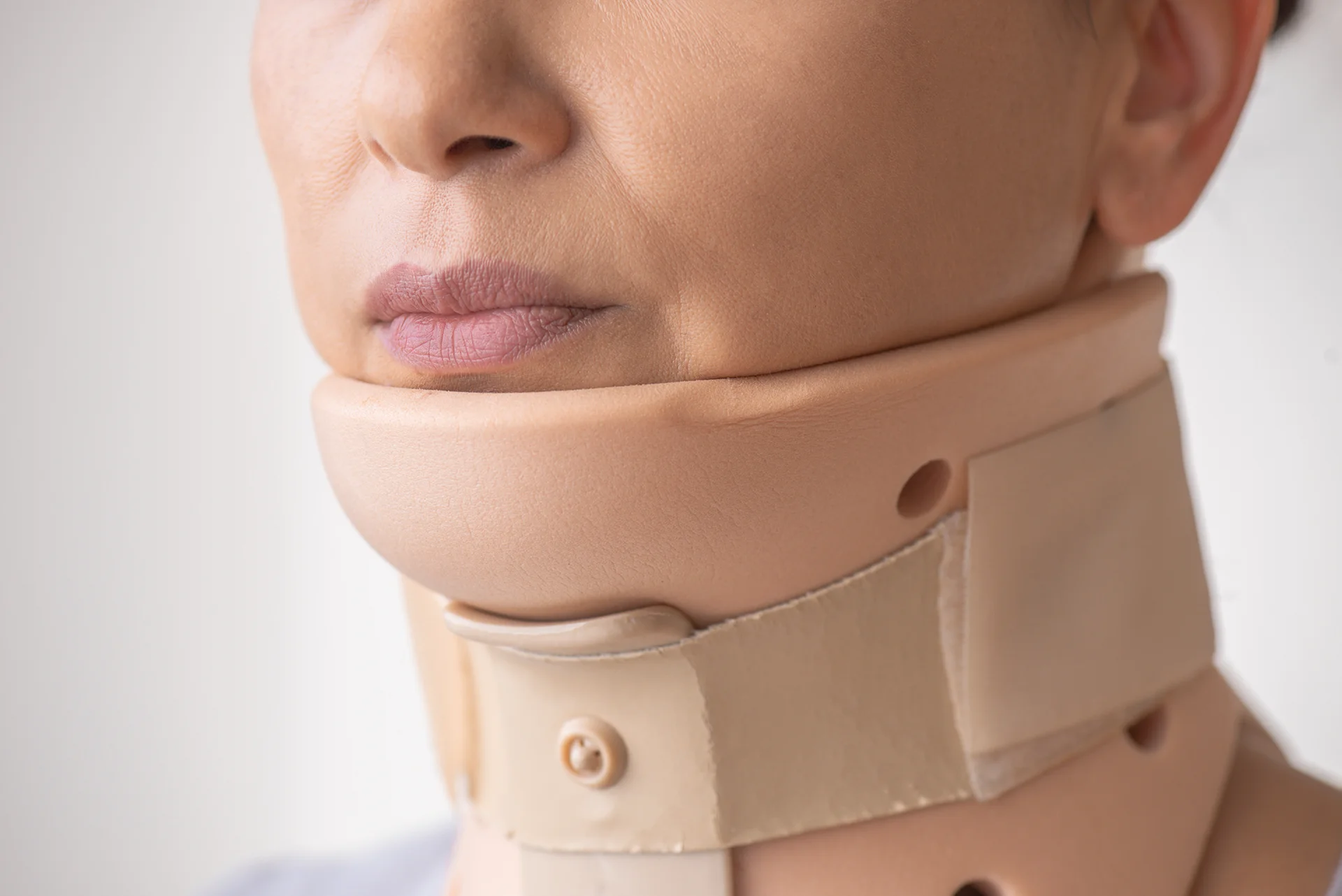Neck pain brings different types of struggles, from difficulties sleeping to problems concentrating at work. Surveys show the 1-year prevalence of neck and shoulder pain is 16-18% in the general US population. According to our experience, a neck brace may be able to provide you with some much-needed relief.
We at Kaly prepared the following informative writeup to help you explore the fundamentals of neck braces and how they can aid in managing different types of neck pain. We’ll cover the most common causes of neck discomfort, provide tips for finding the right stabilizing brace, and outline best practices for use.
An Overview of Neck Pain
The neck is comprised of seven small vertebrae supported by muscles, ligaments, and cervical discs that absorb shock and allow flexible movement. When any of these structures become injured, strained, or inflamed, pain and stiffness can result.
According to our research, some of the most prevalent sources of neck pain include:
- Herniated discs or bulging discs pressing on spinal nerves
This is when a cervical disc ruptures or bulges, putting pressure on spinal nerves and causing neck pain and other symptoms. Herniated discs are also called “slipped” discs. Up to 90% of herniated discs occur in the lowest two cervical vertebrae since that area bears the most weight.
A study on cervical disc herniation published by StatPearls confirms this condition commonly causes neck pain in adults. The pathophysiology involves mechanical compression of nerves by the herniated nucleus pulposus and increased local inflammatory cytokines.
- Degenerative disc disease wearing down cervical discs
Age-related wear and tear causes the cervical discs to degenerate, which can lead to inflammation, nerve irritation, and neck pain. DDD is also called spondylosis. It typically starts in people ages 30-40 as the discs lose hydration and elasticity. By age 60, 95% of people show some signs of cervical disc degeneration.
A study on NCBI states cervical disc degeneration is a common source of neck pain. The degenerative disc has abundant nerve fibers, is prone to inflammation, and can provoke pain when stimulated or distended.
- Injury or whiplash that overstretches the neck ligaments
Whiplash injuries overstretch the ligaments of the neck, which can cause neck instability, pain, and other issues. Women are twice as likely as men to suffer whiplash injuries due to differences in neck strength and posture.
A study on whiplash and its effects on the cervical capsular ligament, published on the NCBI, found that whiplash can cause increased laxity of the cervical capsular ligament, which may be one component perpetuating chronic pain and clinical instability in whiplash patients.
- Spondylosis, which is age-related wear and tear of the cervical vertebrae
Spondylosis is degenerative changes and arthritis in the cervical vertebrae, which narrows the spinal canal and puts pressure on nerves. It worsens with age as cartilage degenerates and bone spurs form. It is estimated 60% of people over age 60 have cervical spondylosis evident on x-rays. However, many remain asymptomatic.
The StatPearls study on cervical disc herniation also mentions that the prevalence of cervical disc herniation, which can be a result of spondylosis, increases with age for both men and women.
- Rheumatoid arthritis, an autoimmune disorder that can affect the upper spine
Rheumatoid arthritis is an inflammatory autoimmune disease that can cause joint destruction and pain in the cervical spine. Up to 80% of rheumatoid arthritis patients develop neck symptoms at some point due to inflammation of cervical facet joints and ligaments. This can lead to instability and myelopathy in severe cases.
A study on the global epidemiology, trends, and risk factors of neck pain, published on the NCBI, mentions that neck pain might occur as a consequence of certain diseases, such as neuromusculoskeletal disorders or autoimmune diseases like rheumatoid arthritis.
Additionally, poor posture, repetitive stress, anxiety, and even sleeping in awkward positions can trigger or exacerbate discomfort. Neck pain may be localized, radiating, or accompanied by headaches, numbness, and tingling.
How Effective Is a Neck Stabilizer for Preventing Causes and Symptoms?
The results are fairly mixed when treating certain conditions like sleep apnea and whiplash.
- A pilot study found that a soft cervical collar was well-tolerated at night by patients with obstructive sleep apnea (OSA). The collar limited cervical and head movements, which can cause upper airway obstruction in OSA. However, the study also noted that the collar was not sufficient to treat sleep apnea on its own, suggesting that it should be used in conjunction with other treatments.
- Another study discovered that the use of a soft cervical collar among whiplash patients was associated with the persistence of symptoms. The study concluded that the use of the collar is a non-recommended practice and seems to be related to an increased risk of delayed recovery.
How Effective Is a Neck Brace for Cervical Pain?

According to our research, neck braces can provide substantial pain relief for many common causes of cervical discomfort when used correctly. By immobilizing and stabilizing the neck muscles and vertebrae, braces limit range of motion that contributes to pain. This allows inflamed joints, strained muscles, and compressed nerves time to heal.
- An NCBI study found cervical collars can provide short-term neck pain relief by limiting motion but long-term use may cause atrophy. Effectiveness varies based on diagnosis. For whiplash, early exercise outperformed collars in reducing pain and disability.
- A Mayfield Clinic study explains neck braces immobilize the spine during healing and restrict movement to control pain. Soft collars are often used for whiplash while rigid braces aid fracture/surgery recovery. Proper use per doctor’s instructions is crucial.
The vital factors in effectiveness are selecting the proper brace design for your condition and wearing it as directed by your physician. Rigid collars that fully restrict motion may be prescribed for disc injuries or post-surgery recovery while a soft collar may be better for muscle spasms or arthritis flare-ups. Things like proper adjustment and compliance with your doctor’s instructions on duration of use also impact outcomes.
- A study comparing the effects of soft and rigid cervical collars on head and neck immobilization found that rigid collars provided more immobilization in all directions compared to soft collars. However, both types of collars were found to limit neck motion, which can aid in the healing process.
While not ideal in all cases, braces are generally regarded as an effective component of treatment plans for many frequently diagnosed sources of neck pain.
Do Neck Braces Help with Trapped Nerves in the Neck?
Yes, if neck pain, tingling, or numbness in your shoulders, arms, or fingers originates from a pinched nerve, a neck brace may very well help alleviate your uncomfortable symptoms.
- A study published in the American Family Physician journal suggests that a short period (one week) of immobilization in a cervical collar may relieve radicular pain, which is pain that radiates along the path of a nerve.
Cervical radiculopathy is the medical term for compression of a nerve root in the neck, most often caused by herniated discs or bone spurs. This frequently results in pain or abnormal sensations along the path of the affected nerve.
By immobilizing the neck and limiting range of motion, braces can take pressure off impinged nerves. Restricting activity provides nerves the rest they need to heal while also preventing additional injury or compression. For moderate to severe radiculopathy, most doctors recommend wearing a brace.
That being said, bracing is usually just one part of an effective treatment plan which may also include physical therapy, steroid injections, or even surgery for severe nerve impingement. However, the stabilization and pain relief a brace provides can certainly aid recovery.
How Does a Cervical Collar Work for Spondylosis?
Braces work by immobilizing and stabilizing the neck to avoid painful motion. A rigid brace limits mobility which contributes to further slippage or deterioration of the cervical vertebrae. The additional external support provided by the brace also eases strain on the neck muscles which must compensate for spine dysfunction.
- A study published by the National Center for Biotechnology Information (NCBI) states that most patients with cervical spondylosis respond to conservative measures, which include short-term immobilization with a cervical collar.
Take note that spondylosis involves age-related degeneration of the cervical discs and vertebrae, which can narrow the spinal canal. This puts pressure on the spinal cord and nerves, resulting in pain.
Improving posture is another key benefit. Braces encourage upright positioning and a more neutral neck alignment. This takes pressure off compressed nerve roots and vertebral joints which may be contributing to discomfort. The stability and posture improvement provided by braces offers relief without risky surgery or medications.
Is a Neck Brace Suitable for Cervical Radiculopathy?
For reducing radicular symptoms stemming from irritated or compressed nerves in the neck, cervical collars are regularly recommended by specialists from Kaly. By immobilizing the neck and limiting the range of movement, neck braces allow impinged nerves time to calm down and heal.
Restricting mobility also prevents the nerve root from becoming repeatedly perturbed. Plus, a brace provides external support to stabilize the vertebrae, taking pressure off the compressed nerves.
- A randomized controlled trial (RCT) by Kuijper et al., published in the British Medical Journal, found that both active treatment (physical therapy + home-based exercise) and passive treatment (cervical collar + rest) were equally effective at relieving acute neck and arm pain caused by cervical radiculopathy. The study concluded that a cervical collar is at least as effective as physical therapy for recent onset cervical radiculopathy, and it costs far less.
- Another study published in the British Medical Journal, as cited by Burlington Sports Therapy, found that patients who wore a neck brace for immobilization fared better than those who did not. The results were statistically significant, suggesting that for patients with acute onset cervical radiculopathy, brief use of a cervical immobilizer might be beneficial.
Cervical radiculopathy can arise from herniated discs, bone spurs, other spine abnormalities, or past neck injuries. The inflamed nerve roots become further agitated with motion and activity.
When considering if a brace may help your radiculopathy, a doctor can assess the severity of your nerve impingement and determine if limiting motion is advisable. Assuming the proper brace and wearing protocol, immobilization can be very beneficial for resolving nerve-related neck and arm pain.
Do Neck Braces Help with Occipital Neuralgia?
According to our research, cervical collars can provide occipital neuralgia pain relief by immobilizing the neck and limiting painful motion that aggravates the occipital nerves. Restricting mobility allows the nerves time to calm down and heal.
- A study mentioned in the NCBI Bookshelf discusses the use of cervical collars for the management of neck pain, including occipital neuralgia. It states that cervical collars can provide symptomatic relief, although the long-term outcome is not clear. The study also mentions that the use of cervical collars is often prescribed by convention for patients complaining of neck pain.
Soft collars provide some stabilization while allowing a small range of motion. Rigid braces fully restrict movement which may be warranted for severe cases.
- Spine-health mentions that if self-care tips don’t ease occipital neuralgia pain, a healthcare provider may prescribe pain medications and/or a guided physical therapy program. In some cases, a doctor may even consider offering a steroid injection to help relieve inflammation and reduce the pain.
Effectiveness depends on the underlying cause of the nerve inflammation. Other treatments like nerve block injections, medications, physical therapy, or surgery may be warranted as well. But stabilizing the neck with a brace is often an important part of an occipital neuralgia management plan.
Can a Neck Brace Improve Neck Pain from Degenerative Disc Disease?
Immobilizing the neck with a brace limits mobility, which can provide the compressed nerves and strained cervical discs time to heal. Restricting movement that stresses the cervical spine also reduces further injury risk.
Braces give external support to the neck, easing the burden on muscles. The additional stabilization can allow inflamed, compressed nerves to calm down.
- A study by Saal et al. investigated 26 patients with cervical herniated nucleus pulposus and radiculopathy, most of whom presented with neurologic loss and were treated non-surgically. All patients were treated with ice, rest, a hard cervical collar worn for up to 2 weeks, NSAIDs, traction, and strengthening exercises. The patients were followed for a 1-year period. However, the study did not isolate the effect of the cervical collar from the other treatments, making it difficult to determine the specific impact of the collar on patient outcomes.
For managing neck pain related to advanced DDD, doctors from Kaly often recommend bracing along with other treatments like physical therapy, anti-inflammatory medications, or steroid injections. By aiding recovery and providing pain relief, neck braces can greatly improve daily function despite significant cervical disc degeneration.
Is a Neck Brace Effective for Sprained Neck Recovery?
Based on our research, using a neck brace is an extremely effective part of recovery following a sprain. Immobilizing the neck allows torn ligaments time to properly heal by limiting painful motion. Braces also provide external support to stabilize the region, easing strain on strained muscles and inflamed joints.
- A study published in HealthCentral suggests that a soft collar can provide neck support that may help reduce soft tissue inflammation and pain in the immediate period (48-72 hours) following injury.
Following an initial period of immobilization, your physician may recommend gently increasing activity while still wearing the brace. Utilizing a brace as part of the supervised treatment plan facilitates healing and prevents re-injury. With proper care, sprained necks can fully recover.
What’s the Purpose of a Neck Brace for Trapezius Pain?
The large trapezius muscles extending along either side of the neck and shoulders are prone to painful spasming and knots, especially from tension, poor posture, or overuse. Limited mobility provided by a neck brace gives strained muscles the rest they require to recover. Braces also promote proper neck and shoulder alignment which eases trapezius tension.
By immobilizing the neck and limiting range of motion, neck braces can interrupt the painful muscle spasm cycle. Restricting movement allows irritated, fatigued muscle fibers to relax. However, neck braces alone rarely resolve chronic trapezius problems long-term.
Additional treatments like trigger point injections, massage, heat therapy, and strengthening exercises are usually needed for ongoing pain management. Healthline suggests that rest and ice can help heal a trapezius strain. It also mentions that exercises to strengthen the trapezius can help reduce the risk of future injuries.
What Is the Best Neck Stabilizer for Sleeping?
Sleeping with neck pain can be enormously challenging. However, wearing a cervical collar at night can provide stabilization that allows more restful sleep. The important factor is choosing a comfortable brace design.
Rigid plastic braces fully immobilize the neck and may be beneficial for stabilizing a severe injury, easing nerve compression, or recovering from surgery. However, they restrict natural movement which some find uncomfortable for sleeping.
A soft foam collar may be a smarter choice for nighttime as it permits some mobility while still providing ample support. Look for wide collars with adjustable closures to customize the fit. Using a cervical pillow along with the brace can also help maintain alignment.
Discuss your options with your doctor and base your decision on the underlying cause of your neck issues. With the right stabilization, a neck brace can mean the difference between a sleepless, pained night and truly restorative sleep.
Where Can You Buy a Neck Collar for Neck Pain?
When searching for the most suitable neck brace, you have several options for where to make your purchase. Many major pharmacies and medical supply stores carry a variety of cervical collars and braces that can be purchased over the counter. This allows you to inspect the quality and fit yourself.
For a wider selection, online medical retailers offer many styles and can ship directly to your home. Measure your neck circumference carefully and closely check sizing charts to ensure a proper fit. Adjustable velcro straps typically allow for modifications.
For a custom brace fit specifically for you, visiting an orthotist or chiropractor experienced in bracing may be warranted. They can recommend the most appropriate design, take exact measurements, and ensure optimal comfort and support. This is especially advisable for long-term use.
Get Customized Care for Your Neck Pain

While neck braces provide stabilization and pain relief for many common cervical issues, they should be used under medical guidance. Consulting an orthopedist or spine specialist allows proper bracing recommendations customized to your needs.
At Kaly, our advanced search platform lets you easily find top local neck and back pain doctors accepting your insurance. Connect with an experienced specialist for personalized care that helps you find real relief.
